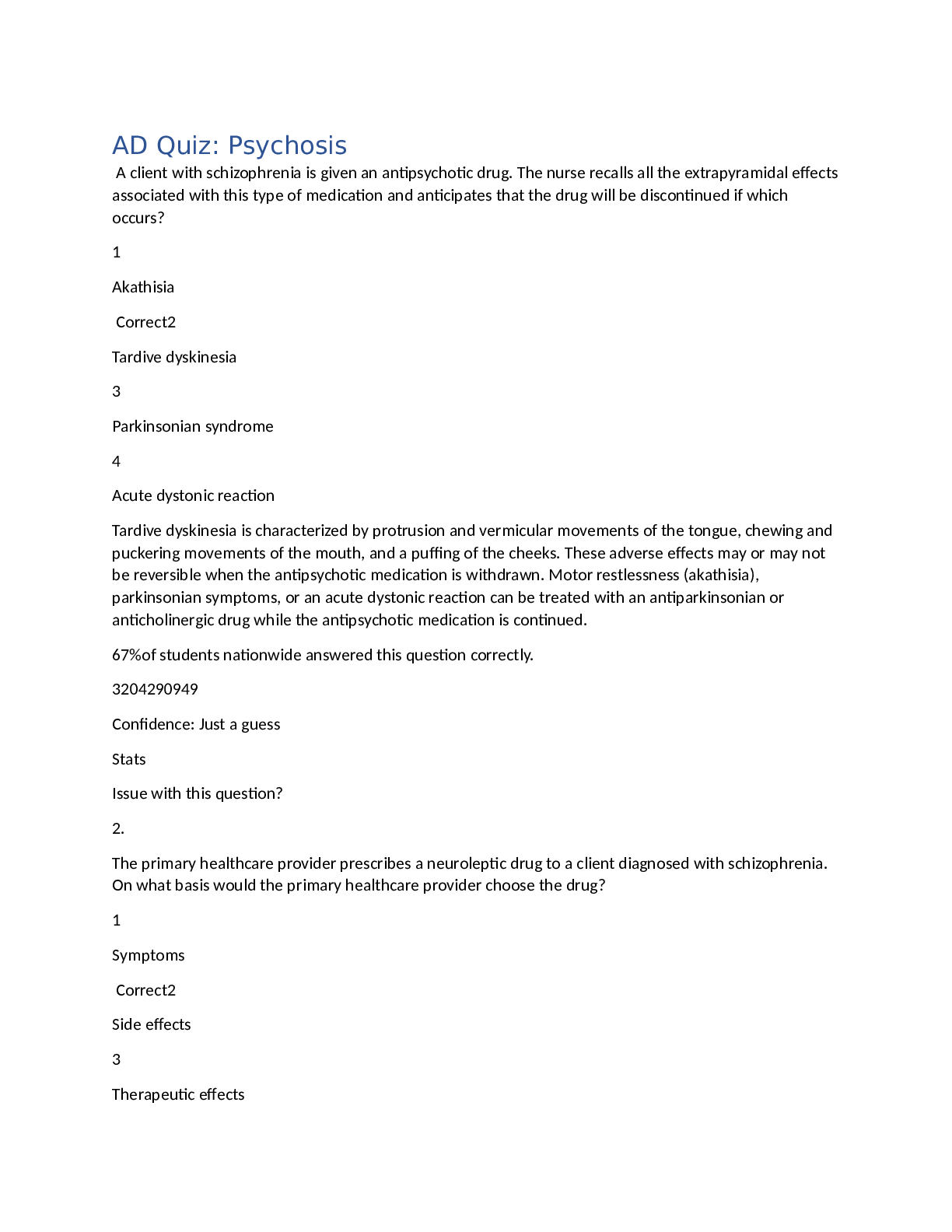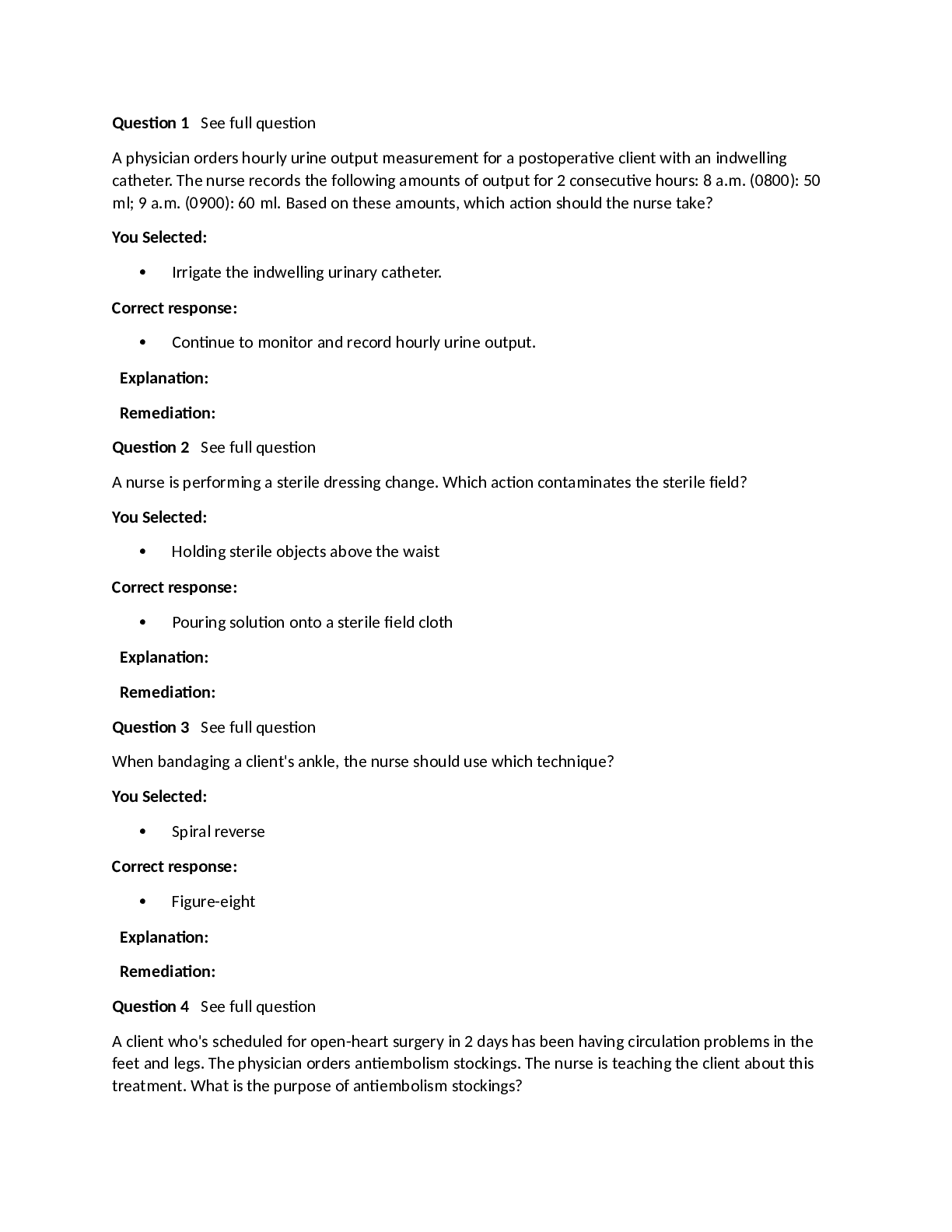Chemistry > QUESTIONS & ANSWERS > Los Angeles Mission College CHEM 012A Chapter 8 Practice Test Answers (All)
Los Angeles Mission College CHEM 012A Chapter 8 Practice Test Answers
Document Content and Description Below
Mission College CHEM-012A:Organic Chemistry Practice Test, Chapter 08 - Alkenes: Reactions and Synthesis Exhibit 8-1 To answer the question(s) below consider the following reaction: When cyclohex... ene reacts with chlorine in carbon tetrachloride the trans-dihalide is formed. Q1. Refer to Exhibit 8-1. Write the complete stepwise mechanism for this reaction. Be sure to show all intermediate structures and all electron flow using arrows. ANSWER: Q2. Refer to Exhibit 8-1. The observed stereochemistry of addition of chlorine to cyclohexene is explained by the intermediacy of a: a.cyclonium ion b.carbocation c.carbene d.chloronium ion Q3. Refer to Exhibit 8-1. Since the two chlorine atoms add to opposite faces of the cyclohexene double bond, we say that the reaction occurs with: a.syn stereochemistry b.cis stereochemistry c.anti stereochemistry d.retention of stereochemistry Q4. Refer to Exhibit 8-1. Provide the IUPAC name for the product of the reaction of cyclohexene with chlorine. ANSWER: trans-1,2-dichlorocyclohexane Q5. Draw both chair conformations of trans-1,2-dichlorocyclohexane on the templates provided below. Circle the least stable conformation. ANSWER: Exhibit 8-2 Consider the reaction sequence below to answer the following question(s):Q6. Refer to Exhibit 8-2. Write the complete reaction mechanism for the first step of this reaction sequence. Show all electron flow with arrows and show all intermediate structures. ANSWER: Q7. Refer to Exhibit 8-2. The intermediate in the first step of this reaction sequence is called a: a.carbocation b.cyclonium ion c.mercurinium ion d.mercapto species. Q8. Refer to Exhibit 8-2. In the second step of this reaction sequence, the organomercury compound is treated with sodium borohydride, NaBH4, to yield the alcohol product. This replacement of a carbon-mercury bond with a carbon-hydrogen bond is termed: a.an oxidation b.a reduction c.a hydroxylation d.a cycloaddition Exhibit 8-3 Consider the reaction below to answer the following question(s). Alkenes may be hydrated by the hydroboration/oxidation procedure shown. Q9.Refer to Exhibit 8-3. The intermediate formed in the first step of this reaction is: a. b. c. d. Q10. Refer to Exhibit 8-3. Hydroboration of alkenes is an example of: a.a rearrangement reaction. b.a substitution reaction. c.an elimination reaction. d.an addition reaction. Q11. Refer to Exhibit 8-3. Hydroboration/oxidation of alkenes occurs with: a.anti stereochemistry. b.trans stereochemistry. c.syn stereochemistry. d.unpredictable stereochemistry.Q12. Refer to Exhibit 8-3. The regiochemistry of hydroboration/oxidation of alkenes is: a.Markovnikov. b.non-Markovnikov c.subject to solvent effects. d.unrelated to alkene structure. Exhibit 8-4 Consider the reaction below to answer the following question(s). When dichlorocarbene is generated in the presence of an alkene, a dichlorocyclopropane is formed. Q13. Refer to Exhibit 8-4. Write the complete stepwise mechanism for the formation of dichlorocarbene, CCl2. Show all intermediate structures and show all electron flow with arrows. ANSWER: Q14. Refer to Exhibit 8-4. Draw the complete Lewis electron dot structure for dichlorocarbene, CCl2. ANSWER: Q15. Refer to Exhibit 8-4. In the reaction of an alkene with dichlorocarbene, the dichlorocarbene is the: a.electrophile. b.Lewis base. c.nucleophile. d.both b and c. Q16. Refer to Exhibit 8-4. The reaction of an alkene with dichlorocarbene is: a.regiospecific. b.Markovnikov. c.stereospecific. d.non-Markovnikov. Exhibit 8-5 The sequence of (1) alkene hydroxylation followed by (2) diol cleavage is often an excellent alternative to direct alkene cleavage with ozone. For this sequence below, answer the following question(s). Q17. Refer to Exhibit 8-5. Draw the structure of A. ANSWER: Q18. Refer to Exhibit 8-5. Give the formula for reagent B. ANSWER: HIO4Exhibit 8-6 Predict the products of each reaction below. Indicate regiochemistry and stereochemistry when relevant. Q19. ANSWER: Q20. ANSWER: 21. ANSWER: 22. ANSWER: POINTS: 123. ANSWER: 24. ANSWER: 25. ANSWER: 26. ANSWER: 27. ANSWER: 28. ANSWER:29. ANSWER: Exhibit 8-7 Choose the best reagent from the list below for carrying out each transformation. Place the letter of the reagent in the blank to the left of the reaction. a. 1. O3 e. 1. OsO4 2. Zn, H3O+ 2. NaHSO3, H2O b. 1. BH3, THF f. KMnO4, acid 2. H2O2, NaOH, H2O c. CHCl3, KOH g. CH2I2, Zn(Cu) d. H2O, H2SO4, heat h. 1. Hg(OAc)2, H2O 2. NaBH4 Q30. _____ ANSWER: b Q31. _____ ANSWER: a Q32. _____ ANSWER: gQ33. _____ ANSWER: h Exhibit 8-8 For each reaction below suggest structures for alkenes that give the indicated reaction products. There may be more than one answer in some cases [Show More]
Last updated: 1 year ago
Preview 1 out of 14 pages

Buy this document to get the full access instantly
Instant Download Access after purchase
Add to cartInstant download
We Accept:

Reviews( 0 )
$11.00
Document information
Connected school, study & course
About the document
Uploaded On
Jul 31, 2021
Number of pages
14
Written in
Additional information
This document has been written for:
Uploaded
Jul 31, 2021
Downloads
0
Views
30

.png)



.png)
.png)
.png)





.png)

 (2).png)
.png)

